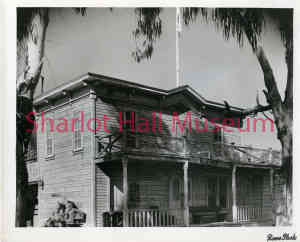Gold Trails Hotel
details
Unknown Unknown 1404.7071.0002.jpg BU-H-7071 B&W 1404-7071-0002 buh7071pb Print 8x10 Historic Photographs 1960s Reproduction requires permission. Digital images property of SHM Library & ArchivesDescription
Street view of the Old or Gold Trails Hotel at Knott's Berry Farm Theme Park in Buena Park, California. The Park began as a roadside berry stand run by Walter Knott and his wife, Cordelia, along State Route 39 in Southern California.
Entrepeneur Walter Knott is credited with propagating the boysenberry plant in the early 1930's. The couple began serving chicken dinners at their stand in 1934 during the Great Depression. The endeavor was successful. Realizing they could take further advantage of their situation, the Knotts had the idea of building a ghost town attraction. He found the first building, the Old Trails Hotel, in 1940. He had it moved and reconstructed from the mostly deserted western stage stop of Bumble Bee, in the former gold country of northern Arizona. The date on the building of 1868 happened to coincide with the date that his grandparents came west. The Old Trails Hotel sign had a humorous scrawl of the letter 'G', as if to hastily change the name to the Gold Trails Hotel. It was the first of many old buildings he found and had re-built to create a western town at Knotts Berry Farm. He later followed it up with other attractions and rides designed to bring visitors to his theme park. This was more than a decade before Disneyland opened in 1955.
Bumble Bee, Arizona, where the Old Trails Hotel was originally located, was a former stage stop that once buzzed with activity. It served as a source of supply for miners prospecting in the nearby Bradshaw Mountains in Yavapai County, Arizona. It is located about 60 miles north of present-day Phoenix. It was on the original Phoenix-to-Flagstaff thoroughfare, "the Phoenix road," and was heavily trafficked until the present-day Interstate 17 was re-routed and bypassed Bumble Bee beginning in the 1956. In addition, as the amount of gold prospected in the area began to diminish, so did the function and desirablity of Bumble Bee. The property was bought and sold numerous times. New owners tried differing schemes to attract visitors to the area, including adding additional western-style buildings and facades in efforts to attract the motoring public. All enjoyed some initial success but interest waned as other locations and attractions on I-17 grew in number. Currently, most of historic Bumble Bee has vanished and most visitors to the area are RVer's and ATV enthusiasts.
Purchase
To purchase this image please click on the NOTIFY US button and we will contact you with details
The process for online purchase of usage rights to this digital image is under development. To order this image, CLICK HERE to send an email request for details. Refer to the ‘Usage Terms & Conditions’ page for specific information. A signed “Permission for Use” contract must be completed and returned. Written permission from Sharlot Hall Museum is required to publish, display, or reproduce in any form whatsoever, including all types of electronic media including, but not limited to online sources, websites, Facebook Twitter, or eBooks. Digital files of images, text, sound or audio/visual recordings, or moving images remain the property of Sharlot Hall Museum, and may not be copied, modified, redistributed, resold nor deposited with another institution. Sharlot Hall Museum reserves the right to refuse reproduction of any of its materials, and to impose such conditions as it may deem appropriate. For certain scenarios, the price for personal usage of the digital content is minimal; CLICK HERE to download the specific form for personal usage. For additional information, contact the Museum Library & Archives at 928-445-3122 ext. 14 or email: orderdesk@sharlot.org.




